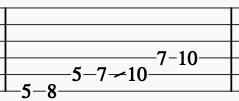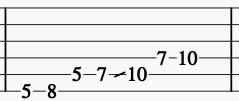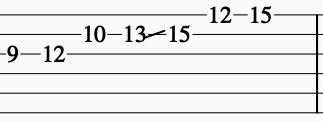Connecting the Pentatonic Scale with Slides (pt. 3/6)
In this lesson we explore the slide as a vehicle to connect through pentatonic positions. Practising slides in this way will also add variety to your articulation and strengthen your left hand technique. If you can connect any 2 positions of string pairs (from last lesson) with slides on the fretboard, you can effectively connect the entire fretboard.
Since this is the 3rd lesson of a 6-part series on the pentatonic scale, this lesson will be way easier for you if you’ve already done some good work on the single strings (lesson 1), and also the string pairs (lesson 2).
The basic pattern
The pattern that we’ll be working with is a seven note pattern that crosses 3 strings, and uses a slide to connect through 2 positions on the guitar. If we start at A, then the arrangement of the notes looks like this:
A C D E G A C
So what ever note you start on, you’ll end up on the note one octave + one scale degree higher. That means if you started on the 2nd note of the scale (C), then you’d end up on a D and the pattern would look like this:
C D E G A C D
Let’s see what the pattern looks like on the fretboard starting from the A on the 6th string:

The EAD String Set
Now you just shift the pattern to start from each note of A minor pentatonic on the 6th string, until you run out of fretboard. Here is the full pattern ascending on the EAD string set:


…and here it is descending:


The other string sets
ADG
Let’s shift this to the ADG string set:


…and the descending pattern:


DGB
Here it is on the DGB string set:


…and descending:


GBE
And finally, here it is on the GBE string set:




With all these slides everywhere, you might need to experiment a little bit with what fingers to use to find something comfortable. If a particular bar feels awkward, spend some more time on it and play around with a few different fingering options. Sometimes you’ll find that you come up with a few fingering options that work just as well as each other, other times one fingering is clearly the winner.
Connecting 2 patterns
You can also connect 2 of these patterns together to form one massive pattern that spans 6 strings and travels through 4 of the traditional pentatonic positions. To do this, connect a pattern that starts on the 6th string with a pattern that starts on the 3rd string. Now the arrangement of the notes looks like this:
A C D E G A C D E G A C D E G
To connect the 2 patterns together, you need to use another slide on the 4th string. Here’s what it looks like on the fretboard:

Notice the extra slide from the 10th fret to the 12th fret. Apart from that, this pattern is the same as connecting this pattern:

With this pattern:

Here’s all of them:



Integrating these ideas into your playing
Patterns are a great way to develop flexibility in your guitar playing. You’re not practising them so you can regurgitate them verbatim in your solos, you’re practising them so you have options of possible notes to play wherever you find yourself on the fretboard.
Having said that, a kind of ‘opposite’ concept to practising patterns is practising improvising. In the video, I use sliding as a ‘theme’ for an improvisation over an A minor backing track I made with my loop pedal.
Basically I try to use slides as much as possible while strictly sticking to the notes of Am pentatonic scale. I tried to cover different areas of the fretboard and use the ideas I worked on in my pattern practise to inform what I played.
The point is not to play a ‘good solo’, it’s to increase your confidence in knowing where the notes of Am pentatonic scale are, and to play things you’ve never played before. Don’t be afraid to work a small area, play the same things over and over, and to sound ‘bad’. Remember, you’re supposed to be practising, not performing.
If you work on improvising in this manner, over time you’ll find that the patterns start to become part of your playing and they won’t sound like a person regurgitating a bunch of patterns they learned.
FINAL THOUGHTS
Try structuring your practise session so that you start with something really strict and then move towards playing with less and less restriction.
1) Being super strict could mean to play the patterns exactly right, come up with a comfortable and effective fingering for every note and repeat each fragment until you can play it confidently. Be thorough with it by taking the whole pattern, or a portion of it, all over the fretboard.
2) Then you could try varying the pattern. See how many variations of one pattern you can come up with. With that exercise, you could just focus more on varying one thing in one area, rather than playing the whole fretboard. It is a good idea to move it to a few different areas though, so spend time in one and then do the same in a few others.
3) Next you could take the essence of the idea of what you’re working on and improvise with it. In this case it’s sliding and shifting from one position to the next. Try improvising with small 2-5 note phrases that focus on sliding or shifting. They may or may not use things you worked on in the exercises in this lesson. This is fun to do with a backing track like I demonstrated in the video.
4) Allow some time at the end of the practise session to just let rip and play whatever you want. You can stick to the notes in Am pentatonic, or you can abandon them altogether – up to you! Play with a backing track…or don’t. Or do and then don’t! This ‘letting go’ step, is more valuable than what it seems.
Take your time with this stuff and have fun! When you’re ready, move on to part 4.





